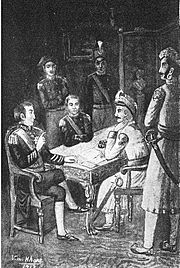Treaty of Bassein (1802) facts for kids
The Treaty of Bassein was an important agreement. It was signed between the English East India Company and Baji Rao II. He was the Peshwa, or leader, of the Maratha confederacy. The treaty was signed on December 31, 1802. This happened after the Battle of Poona, in a place now called Bassein (Vasai).
This treaty was a big step in the end of the Maratha Empire. It led to the East India Company taking control of Maratha lands in western India by 1818.
On May 13, 1803, Baji Rao II became Peshwa again. But he was now under the protection of the East India Company. This meant the Maratha state became a helper, or "client," of the British. The treaty helped the Company rule spread across India. However, not all Maratha leaders agreed with the treaty. This disagreement led to the Second Anglo-Maratha War.
Contents
What the Treaty Said
The Treaty of Bassein had several key points:
British Troops and Payments
- About 6,000 British soldiers would always stay with the Peshwa.
- The Peshwa had to give the East India Company land that earned 2.6 million rupees. A rupee was a type of money.
Peshwa's Limited Power
- The Peshwa could not sign any other treaties without asking the Company first.
- He also could not start a war without getting permission from the Company.
- If the Peshwa had any land disagreements, the Company would decide who was right. This included disputes with leaders like the Nizam and the Gaekwar.
Other Important Rules
- The Peshwa had to give up his claims to the cities of Surat and Baroda.
- He also had to make sure no Europeans worked for him.
- The Peshwa had to talk with the British about how he dealt with other countries.
See also
- Treaty of Poona


